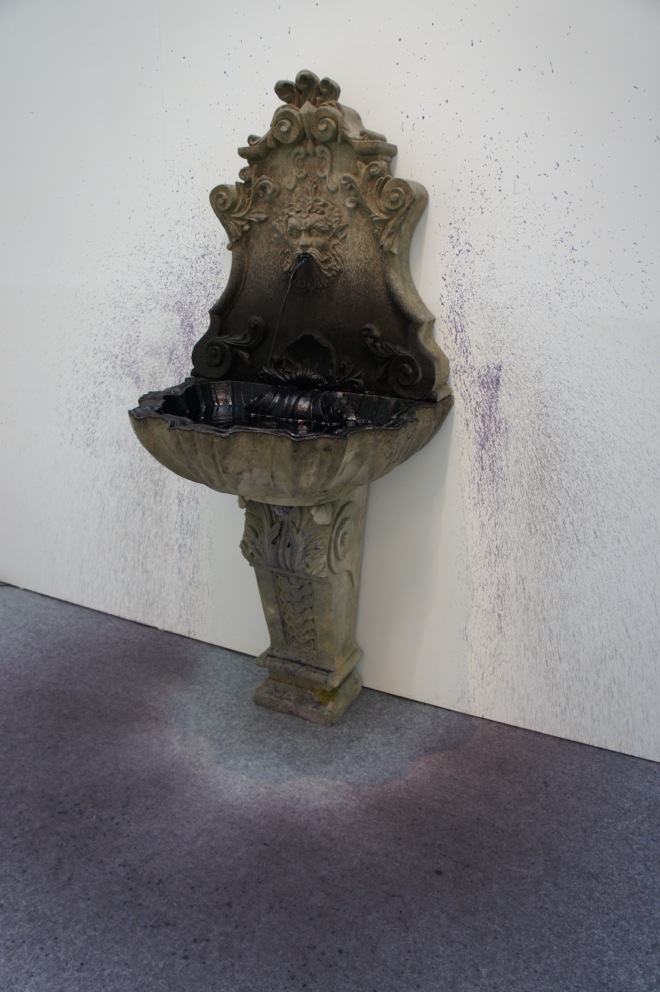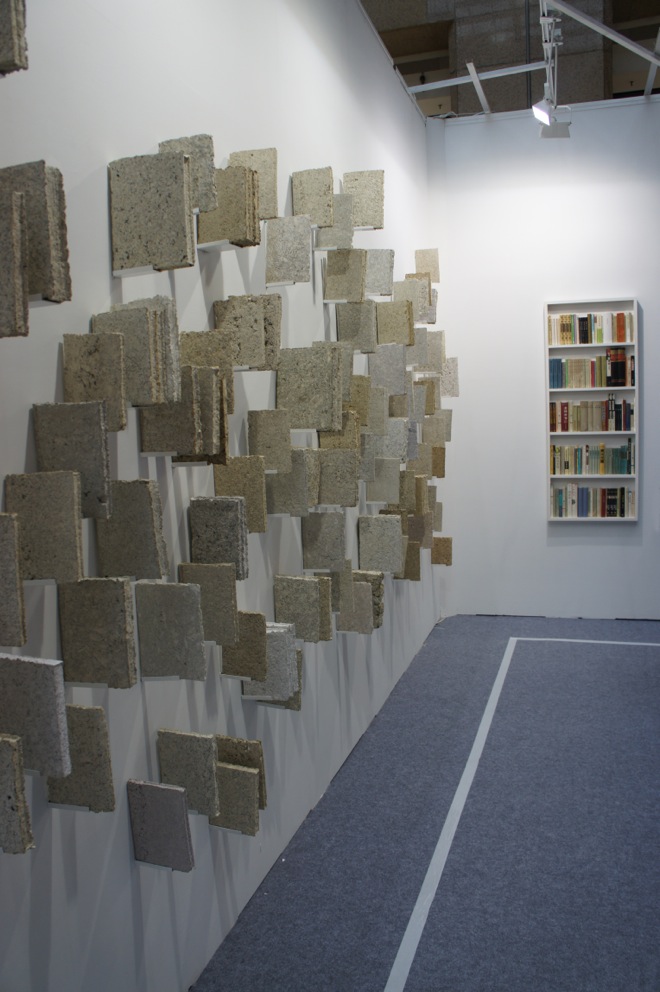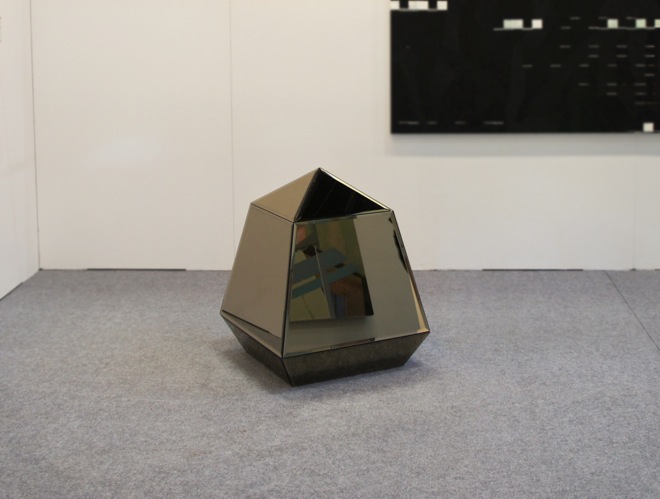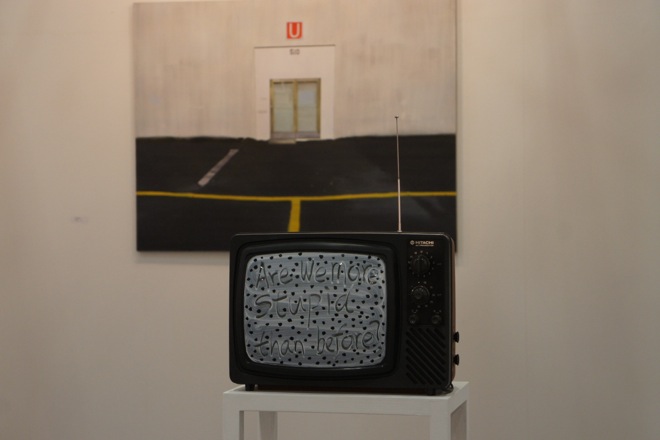Celebrating its 20th anniversary this year, the Art Taipei 2013 opened its doors to the largest contingent of galleries from Hong Kong and the Mainland ever. Many locals therefore more or less came with the expectation that the quality seen in Art Basel Hong Kong (May 2013) would serve as a positive model for Taipei. After all, the main galleries were practically the same ones in attendance in May; moreover, this was the first time for many galleries to exhibit in Taiwan.
Amid all this, the familiar family-run space, de Sarthe Gallery looked busy at their booth. However, compared with last year when numerous galleries reaped a generous harvest as early as opening day, this year only the veterans were able to entice collectors.
This year’s fair also brought about a little heated debate when a work by Jim Lambie, originally arranged to be situated in the middle of the walkways between the booths, was rumored to be removed due to pressure from a local gallery, though the fair organizers cited security concerns [update: see below]. Instead, there was Takeshi Murakami’s “6 Princess,” offering a fantastic opportunity for Kaikai Kiki gallery booth to harness foot traffic with hordes of tourists huddled around taking photos with the cosplay-inspired piece.
It is not difficult to notice that Art Taipei’s PR approach clearly differed from Hong Kong (its natural competitor), with local institutions benefitting from their connections to the fair. Asia Art Center, for instance, got the publicity machine fired up for several films made about their artists by the Discovery channel. Meanwhile, Eslite Gallery, a member of the Art Taipei Executive Committee, enjoyed a home-field advantage with a booth for its own bookstore, where the best-selling book was naturally about Daido Moriyama — an artist promoted by this year’s organizers of the fair. As well, a large number of works seen in May in Hong Kong emerged in smaller formats here. Meanwhile, many impressive works were shown in more low-key format and somewhat marginalized positions at this regional fair [note correction below]. One of these was Su-Mei Tse’s stone installation, “The Source,” standing in one corner of the Eslite booth. The rolling ink quietly, flowed continually from the fountain and circulated over and over again.
[Corrections: the previous version may have led to confusion that Su-Mei Tse's work was presented in Hong Kong. It was not, and the current version makes it clearer.]
[update: Though the fair organizers cited security concern, one Taiwanese press reported that Tina Keng was observed to publicly complain that the work "hindered entry and viewing." When the fair organizers removed the installation on the opening night, Tina Keng was reported to have expressed relief at finally "being able to get some fresh air." See link—in Chinese only.]
2009-Chairs-gloss-paint-mirrored-handbags-椅子、光澤塗料、鏡面手袋-150-x-150-x-150-cm.jpg)
Removed from the fair: Jim Lambie, “I Remember (Square Dance)”, chairs, gloss paint, mirrored handbags, 150 x 150 x 150 cm, 2009
被移除的作品:Jim Lambie, 《我記得(廣場舞)》 ,椅子、光澤塗料、鏡面手袋, 150 x 150 x 150 cm, 2009
Some say that Art Taipei has always been a magnet for Japanese galleries; however, this mainly refers to the medium and lower-priced works. In fact, Silverlens from the Philippines, having received much interest during the Hong Kong fair, was well rewarded for participating in the fair; after all, artists from this region still fetch quite reasonable prices. Yet some galleries with higher-priced works, like Ben Brown Gallerywhere Andreas Hecker manned the booth himself, had a harder time due to the reticence of the local audience. Though Mainland galleries generally did not repeat their good fortune from last year, works in the right price categories still managed decent outcomes.
ShanghART’s curious booth nearly doubled in size from their first time last year. However, the selection this year was rather carefree in mixing the new and the old, and had hints of their Shanghai exhibition “Clutch.” But in terms of footfall, it was certainly not as crowded as last year when their booth featured the works of Sun Xun and other ShanghART notables.

Robin Rhode, “The Point of Vanishing”, 2012-13 [Lehmann Maupin Gallery]
Robin Rhode,《The Point of Vanishing》,2012-13,[乐曼慕品画廊]
Overall, this fair had an unusual number of two-dimensional works, and was therefore judged to be a more conservative edition. In fact, even local galleries known for their video works displayed paintings by such artists as Yan Pei-Ming in their booths. In my long stubborn attempt to discover video works, I managed to make my way to Edouard Malingue Gallery, situated on the edges of the hall. Though they had last year exhibited a large-scale installation by Laurent Grasso, this time, they only displayed a 12’30’’ single-channel video, “Psychokinesis” (2008). While the cathode blinkered, the image of a boulder levitating over a barren field was shown. Such a concrete object ended up being read very non-concretely here—as though any reference of time was being lost. In a way, this also symbolized how since Art Basel landed in Hong Kong, the Taipei fair feels a bit up in the air.

Shi Jinsong, “Scenes from an Unpredictable Theatre”, 2012-13 [MOT/ARTS]
史金淞,《不可预知的戏剧现场》,2012-13,[MOT/ARTS]





